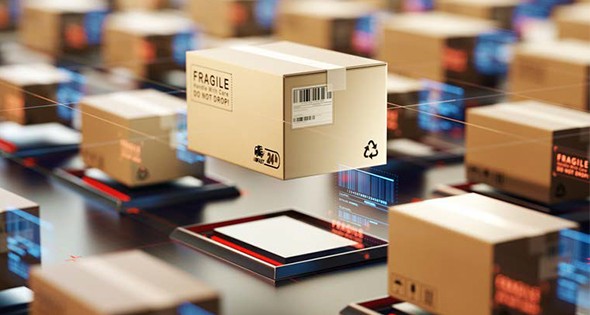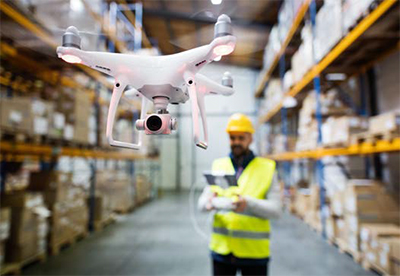
The Future of Logistics
20 Nov, 2018
Quicker, more agile reaction to e-commerce consumer demands continues to be the focus of the logistics industry.
According to ŌĆ£The Economist,ŌĆØ moving goods internationally from factory to factory and warehouse to warehouse today requires many more capabilities than shifting items from local warehouses to doorsteps. But it also accounts for 90 percent of the logisticsŌĆÖ industryŌĆÖs global revenue.
Freightos, an online freight marketplace, recently published their state of online freight sales survey, ŌĆ£2018: Customer Centric FreightŌĆØ. That survey reported that, in the U.S., 97 percent of importers are small businesses, accounting for a third of all imports, some $800 billion worth of goods.
These are the companies where consumers expect a better level of service, and where a logistics company steeped in digital transaction processes can quickly create a successful operation, as opposed to larger and less nimble legacy operations where huge container ships serve manufacturing needs, for example. ŌĆ£ItŌĆÖs still early for digital forwarders, which is why they cannot yet compete on capacity, price, personnel, or global coverage,ŌĆØ the Freightos report stated.
Becoming customer-centric is the key
ItŌĆÖs not just the usual logistics players like FedEx or DHL or UPS pushing for freight digitization.
Amazon is leveraging their expertise of rapidly defining, scaling and perfecting customer-centric technology to become a comprehensive logistics services provider, according to the Freightos report. Asian powerhouses like JD.com and Alibaba are following suit.
Logistics developers agree that itŌĆÖs a customer-centric world in logistics today, where customers are more frequently using an ŌĆ£omni-channelŌĆØ convenience process ŌĆō ordering through an app, then picking up the purchase in the store ŌĆō and expect quality service from start to finish.
This consumer-driven reality is a real game-changer for the logistics world. Just read what Erich Gampenrieder, the global head of the KPMG International Operations Center of Excellence, wrote in his introduction to the KPMG report, ŌĆ£Demand Driven Supply Chain 2.0ŌĆØ: ŌĆ£Picture the following scene: youŌĆÖre outdoors and you hear thunder, and, looking up to the sky, you see a large, gray rain cloud. You take out your smartphone and find a website selling umbrellas. Having selected your style and color, you press ŌĆśorderŌĆÖ, and a mere 5 minutes later, a drone is hovering above you, gently delivering the purchase into your arms ŌĆö just as the first raindrops begin to fall.ŌĆØ
According to the KPMG report, there is a growing need for omni-channel strategies, but that will make supply chains considerably more complex, as companies seek to satisfy customers online, by phone, and via retail and other physical locations. And if they canŌĆÖt, they lose big money quickly.
Where retailers face challenges
The report cited one example where a retailer, The Finish Line, couldnŌĆÖt keep up with a surge of sales in Christmas, 2016, after setting up a new digital infrastructure to fill online orders. The company lost $32 million in sales, which contributed to them closing 600 stores.
According to Retail Systems Research (RSR), a retailer seeking to increase its e-commerce presence faces three key challenges: the existing supply chain is not structured to accommodate high volumes of direct-to-consumer shipments; existing warehouses cannot accommodate high volumes of direct-to-consumer shipments; and new processes are needed to help retailers accurately and efficiently account for online purchases returned to stores.
An article written by the Commercial Real Estate Development Association explains the new host of challenges in logistics using a simple allegory: If consumers, retailers and manufacturers are the actors and retail goods are the props in this play, then transportation and logistics firms ŌĆö which drive to, dock at, load and unload goods at ports, industrial sites, retail facilities and now homes and offices ŌĆö are the stage crew, the invisible hands that move items behind the scenes.
This ŌĆ£stage crewŌĆØ, the article said, represents more than six million people and is expected to add 270,000 in 2018 alone.
Experts say logistics challenges can be overcome by focusing on collaboration among competitors, so vehicles and containers are at least partially full on return trips, there is increased cross docking and dynamic vehicle routing in urban areas, with robotics, automation and sensors helping to move goods and track inventory.
Angling for more apps
One way to address these challenges are apps being developed for logistics that take their cue from Air BnB and Uber.
As described in the 2017 McKinsey and Company quarterly report ŌĆ£Reinventing the core,ŌĆØ an Uber-like shipping platform being developed in China links merchants with multiple logistics companiesŌĆÖ trucking fleets and drivers, enabling the companies to share capacity when they have room. The app also helps mobilize an on-demand pool of thousands of independent urban Chinese delivery drivers.
The service provides dynamic profiles of drivers, their delivery records, and their capabilities – such as whether they do unpacking or installation work. It also enables users to rate drivers, encouraging merchants to turn to competing logistics services (beyond their contracted vendor) or to the many independents they might previously have considered unreliable.
The app offers pricing information, a detailed trip planner, and route maps that help drivers better navigate traffic and improve delivery times. It provides a sequence of suggested pickup sites and optimizes loads for the size of the vehicle.
The McKinsey report showed that the app has allowed established players to reduce fleet costs by 30 percent in some cases and avoid cancelled orders.
Getting the message out.
But for the most part, companies are not quite understanding the need for and the working complexities of digitization when it comes to logistics.
Dr. John Gattorna, an author, educator and thought-leader on enterprise supply chains, has worked with companies such as Dell, Ralph Lauren and Unilever about using a new model of supply chain development.
He says that, around 2010, with more data generated by sensors around each stage of the supply chain getting traceability data of supply movement and more, speed and efficiency of delivery should be possible if an organization can correctly organize the increasing amounts of data they are gathering, and change their internal culture to work smarter and faster.
Gattorna promotes an idea called ŌĆ£clock speed.ŌĆØ ŌĆ£What we are talking about is a natural cadence inside any organization, a rhythm of the way things work,ŌĆØ he says. ŌĆ£If the cadence inside the organization is slower than the volatility of the market on the outside, you are going to end up with huge misalignments that are going to be expensive and pretty miserable.ŌĆØ
He says that companies could get away with being slower to delivery until the internet and online ordering began early this century. ŌĆ£Now you start to see customers flexing their muscles saying we want this and we want that and we want it fast.ŌĆØ
Clock speed means running at that faster tempo all the time, instead of building up supply chain agility every so often which creates costs related to ŌĆ£winding upŌĆØ and bringing redundancies back online, or issues related to transporting stock back to a place where it can be sold.
Gattorna advises companies to do ŌĆ£outside-inŌĆØ thinking. Most supply chains in the 1970s and 1980s were all based on inside-out thinking, he says, looking out in the marketplace and taking a view of what is needed, then setting about creating initiatives within the business. ŌĆ£But then you find that you made some assumptions about the outside world, and a lot of it has been around this idea that one size fits all – that the marketplace is one big market and we just design the perfect supply chain to connect to it,ŌĆØ he says. ŌĆ£The reality now is that people are different, in fact there are lots of differences in people.ŌĆØ
He says that advanced thinkers about supply chain have been able to segment the marketplace into four or five different buying behaviors ŌĆ£which gives us about 80 percent fit to the marketplaceŌĆØ, and design the companyŌĆÖs internal process, equipment and organization design on the basis of using that understanding as the frame of reference. ŌĆ£In other words, trying to get a direct connection to the marketplace,ŌĆØ Gattorna says. ŌĆ£Then take that information and use it to inform how we design our internal supply chain to reduce misalignments and create more efficiencies.ŌĆØ
According to a survey conducted by McKinsey, despite the supply chainŌĆÖs potential impact on the growth of revenues and profits, only two percent of the companies they surveyed reported that supply chains are the focus of their forward-looking digital strategies. Instead, the survey showed that distribution channels and marketing are the primary focus of digital strategies (and investments) at 49 percent of companies.
A 2016 KPMG survey seemed to affirm this lack of commitment to digitization, showing findings where just 13 percent of senior global manufacturing executives say they have ŌĆ£complete visibilityŌĆØ of supply and capacity information across suppliers and logistics partners.
But retailers like Walmart and Amazon have invested millions in specialized software, robotics and other high-tech approaches to track inventory, so that, at a glance, they can find out what customers want and when they want it, trace the progress of every order, and view inventory levels and production schedules.
ItŌĆÖs all a part of being both flexible and agile, responding to the question: As companies attempt to shift from efficiency and cost-savings to grow market share, how do they create responsive supply chains that offer differentiated services, are value driven, flexible and agile?
Side Note
ONTARIO, CALIFORNIA
The City of Ontario, located in Southern California, is ŌĆ£Leading the WayŌĆØ with urban lifestyle districts that create sustainable places to live, work and play. Just 35 miles east of downtown Los Angeles, the City of Ontario is ideally situated as the gateway to Southern California.
At the center of the City is the Ontario International Airport, which is the 15th busiest airport in the nation measured by air cargo. Major airlines including American, Delta, Frontier, JetBlue, United and Southwest, offer daily passenger service through the airportŌĆÖs two busy terminals, and plans are in place to add a third terminal as traffic continues to increase. United Parcel Service (UPS) has their Western Regional Hub located at the Airport, which averages 38 planeloads of packages a day.
Ontario offers a transportation corridor that extends throughout Southern California and across the continental United States and sits 45 miles from the two largest ports in the country. Ontario provides strategic access to the Ports of Los Angeles and Long Beach through its interconnected freeway and rail systems. Ontario also offers the advantage of being in the Foreign Trade Zone, which allows products to be stored, manipulated, manufactured, and exhibited without paying customs duties. The ability to increase international sales, realize greater export potential and succeed in global markets is often a deciding factor for location, relocation and expansion into Ontario.
The mass of freight transport ŌĆō via both rail and road ŌĆō run through the City of Ontario. Three major interstates crisscross the City and the surrounding area: Interstate-15 from San Diego to Las Vegas and beyond; Interstate-10 from west coast to east coast; as well as State Route 60 for easy regional access.
Whether your company is a start-up or celebrating many years in business, looking to relocate or planning to expand, Ontario officials know the best way to attract business is by making it easy to do business. The City of Ontario has expanded by listening to businessŌĆÖ needs and constantly improving its business environment to strengthen its competitive advantage in the marketplace.
To find out more information about the advantages of doing business in Ontario, California visit www.ontariothinksbusiness.com or call 909.395.2005. You can also follow us on twitter at @OntarioEDA.











